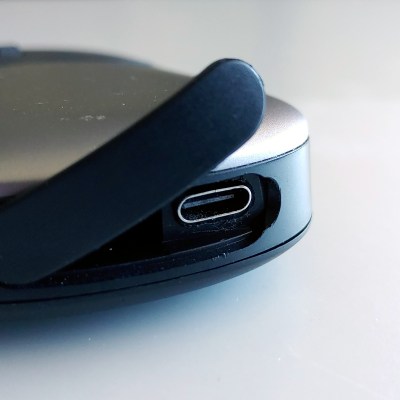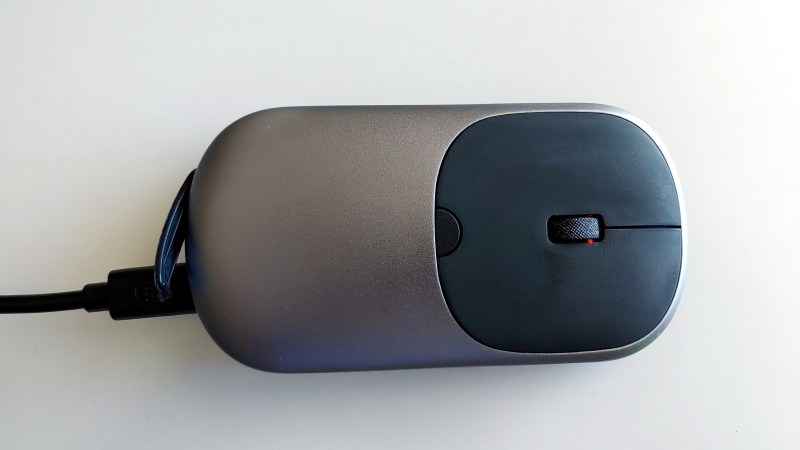Hardware hacks have something in common with renovations that involve taking down a wall: until one actually gets started and opens things up, there’s no telling what kind of complications might be lurking. [voussoir] has a project that demonstrates this nicely: modifying a rechargeable mouse to use USB-C instead of micro-B turned out to have quite a few little glitches in the process. In fact, changing the actual receptacle was the simplest part!
On one hand, the mouse in question seems like a perfect candidate for easy modification. The enclosure isn’t too hard to open, there is ample space inside, and USB is used only for recharging the battery. So what was the problem? The trouble is something familiar to anyone who has worked on modifying an existing piece of hardware: existing parts are boundaries to hacking work, and some are less easily modified than others.

In [voussoir]’s case, the first little glitch was that the small PCB hosting the original mini-B receptacle had a screw hole in it, used to keep it secure during repeated plugging and unplugging. Ensuring the new USB-C receptacle used the same screw was a bit of a pain, but after dealing with that there was another issue: [voussoir] had mounted the new USB-C receptacle flush with the plastic of the mouse, but that didn’t allow a cable to seat fully. The receptacle needed to protrude a bit, or the charging cable couldn’t plug in far enough. Back to the workbench, and so it went for a few more iterations.
The modification was ultimately successful, but the ordeal demonstrates how having to work around physical design constraints can bring unexpected issues. It’s bad enough when one is just making a minor hardware tweak to an existing mouse, let alone entirely recreating vintage Apple mice designs for modern computers.
















There was absolutely no need to engineer a solution that used the same mounting screw as the original. Hot glue is perfectly suitable for securing a small connector such as this, and with some liberal application you can even make it stronger than the original. Plus if you need to make adjustments post install like what happened here, you just pry off the glue, reposition, and then tack it down again.
Nobody is going to open your mouse and criticize you for it looking messy inside. Many manufactured electronics contain some hot glue and other various goops to hold critical complements in place and prevent shorting, so it’s fine to take the similar shortcuts especially for something that only you will use.
Components, not complements. An edit button would be nice.
For items like that I would never go the route of changing the socket but add an cheap adapter to the cables I’ve already got. They come with a little chain which you can clip onto the USB-C cable…
It’s not like that mouse needs recharging every other day, so…
But as some wise person once said: “This is Hackaday, not buy-on-amazon-aday”, so I guess my points are invalid haha
Magnetic bits also work well, when it’s for charging only.
I’d have gone all the way and stuck an inductive charging coil in the mouse. Look ma, no cables at all.
And put the receiver in the mouse pad, forever charged!
I did something similar, except it was homemade adapters I put inside anything with an easy open battery enclosure. The kids’ DS’s, my retro emulator console, anything. There was just a “zone” on my office desk where you’d set your gadget to charge.
I have some mice from Aldi or Lidl that gets powered (not charged) from the mouse pad.
It’s by doing stuff like that that hone and fine tune your skills that can apply to who knows how many things. It’s called tinkering. I mess with stuff like that for fun or to get my brains creative juices flowing to address another project.
And by the way, I’ve used many a hot glue stick for mannny projects. That is definitely some awesome stuff, I can agree : )
I also agree with hot glue. No need to make your life more complicated with using the same screw and all that. Hot glue is best.
This is just the sort of real world problem that might be faced by an engineer. “We want to switch to usb-c charging, but not but new tooling for the molds. Minor modifications to the molds is acceptable cost wise though. We also do not want to reengineer or assembly process at the factory, so retaining a screwed in board is a high priority”.
I bet you to fix Apple’s (dumbest) Magic Mouse.
I dare you* (fuck!)
Unnecessary Inventions on YouTube did it already.
If you leave the cable attached, you can take out the batteries an reinvent the wired mouse.
I’ve been known to secure PCBs inside enclosures using self-adhesive velcro. Weirdly effective. Hot glue is also quite valid. Lots of zipties inside devices on the market, too.